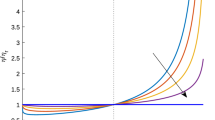Abstract
P. B. M. Walker (1954) and H. C. Longuet-Higgins (quoted by Walker), as well as O. Scherbaum and G. Rasch (1957), made the first attempts towards a mathematical study of the age distribution in a cellular population. It was H. Von Foerster (1959), however, who derived the complete differential equation for the age density function,n(t, a). His equation is obtained from an analysis of the infinitesimal changes occurring during a time elementdt in a group of cells with ages betweena anda+da. The behavior of the population is determined by a quantity λ which we call the loss function. In this paper a rigorous discussion of the Von Foerster equation is presented, and a solution is given for the special case when λ depends, ont (time) anda (age) but not on other variables (such asn itself). It is also shown that the age density,n(t, a), is completely known only if the birth rate,α(t), and the initial age distribution, β(a), are given as boundary conditions. In Section II the steady state solution and some plausible forms of intrinsic loss functions (depending ona only) are discussed in view of later applications.
Similar content being viewed by others
Literature
Buckland, W. R. 1964.Statistical Assessment of the Life Characteristic (Number 13 of Griffin's Statistical Monographs and Courses)., London: Charles Griffin & Co.
Gumbel, E. J. 1958.Statistics of Extremes. New York: Columbia University Press.
Harris, T. E. 1963.The Theory of Branching Processes. Berlin-Göttingen-Heidelberg: Springer.
Johnson, Horton A. 1960. “Some Problems Associated with the Histological Study of Cell Proliferation Kinetics.”Cytologia,26, 32–41.
Kendall, David G. 1948. “On the Role of Variable Generation Time in the Development of a Stochastic Birth Process.”Biometrika,35, 316–330.
— 1949. “Stochastic Processes and Population Growth.”J. Roy. Stat. Soc.,11 B, 230–264.
— 1952. “Les processus stochastiques de croissance en biologie.”Ann. Inst. H. Poincaré,13, 43–108.
Lotka, Alfred J. 1956.Elements of Mathematical Biology. New York: Dover.
Patt, H. M. and M. A. Maloney. 1959. “Kinetics of Neutrophil Balance.” InThe Kinetics of Cellular Proliferation, pp. 201–207, edited by F. Stohlman, Jr., New York: Grune and Stratton.
Quastler, H. 1960. “Cell Population Kinetics.”Ann. N.Y. Acad. of Sciences,90, Art. 2, 580–591.
— 1963. “The Analysis of Cell Population Kinetics.” InCell Proliferation, pp. 18–34. edited by L. F. Lamerton and R. J. M. Fry, Oxford: Blackwell Scientific Publications.
Rescigno, A. and G. Segre. 1961.La cinetica dei farmaci e dei traccianti radioattivi. Torino: Edizioni Universitarie, Boringhieri.
Sacher, G. A. 1955. “Progress Report: Gamma Ray Toxicity Program, III. Mathematical Analysis of the Behavior of Cellular Systems.”Argonne National Laboratory Quarterly Report of Biological and Medical Research Division. ANL-5486, pp. 47–52.
Sacher, G. A., E. Trucco, and J. H. Borrowman. 1958. “Mathematical models for the formation and regulation of populations of formed blood elements. I. Some basic concepts and a first specific model.”Argonne National Laboratory Semiannual Report; Division of Biological and Medical Research. ANL-6093, pp. 46–54.
Sacher, G. A. and E. Trucco. 1959. Progress Report: “Dynamics of Cellular Populations.”Argonne National Laboratory Semiannual Report; Division of Biological and Medical Research, July through December, ANL-6264, pp. 52–54.
Scherbaum, O. and G. Rasch. 1957. “Cell Size Distribution and Single Cell Growth in Tetrahymena Pyriformis GL.”Acta Pathol. et Microbiol. Scandinav.,41, 161–182.
Sheppard, C. W. 1962.Basic Principles of the Tracer Method. New York and London: Wiley.
Tricomi, F. G. 1950. “Asymptotische Eigenschaften der unvollständigen Gammafunktion.”Mathem. Zeitschrift,53, 136–148.
— 1954.Funzioni Ipergeometriche Confluenti. Roma: Edizioni Cremonese.
Von Foerster, H. 1959. “Some Remarks on Changing Populations.” InThe Kinetics of Cellular Proliferation, pp. 382–407, edited by F. Stohlman, Jr New York: Grune and Stratton.
Von Foerster, H. 1961. “Mitotic Indices of Dividing and Differentiating Cells.”Electrical Engineering Research Laboratory, Engineering Experimental Station, University of Illinois, Urbana, Illinois. United States Public Health, Grant C-4044, Report No. 3, February 1961.
Walker, P. M. B. 1954. “The Mitotic Index and Interphase Processes.”J. of Exptl. Biol.,31, 8–15.
Whittlesey, John R. B. 1963. “Incomplete Gamma Functions for Evaluating Erlang Process Probabilities.”Mathematics of Computation,17, 11–17.
Author information
Authors and Affiliations
Additional information
This work was performed under the auspices of the U.S. Atomic Energy Commission.
Rights and permissions
About this article
Cite this article
Trucco, E. Mathematical models for cellular systems the von Foerster equation. Part I. Bulletin of Mathematical Biophysics 27, 285–304 (1965). https://doi.org/10.1007/BF02478406
Received:
Issue Date:
DOI: https://doi.org/10.1007/BF02478406




